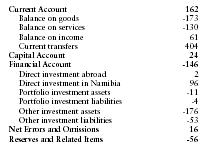Namibia - Balance of payments
Traditionally, Namibia has maintained a trade surplus resulting from its valuable mineral exports. However, over 95% of Namibia's consumption and investment goods are imported, resulting in wide fluctuations in the merchandise trade surplus due to the constant changes in world mineral prices. Namibia joined the IMF in September 1990, when it began opening more to foreign trade. In recent years, the current account has maintained a surplus, due to surpluses in net current transfers, particularly in Southern African Customs Union receipts and foreign development assistance not linked to capital assets.
The US Central Intelligence Agency (CIA) reports that in 2001 the purchasing power parity of Namibia's exports was $1.58 billion while imports totaled $1.71 billion resulting in a trade deficit of $130 million.
The International Monetary Fund (IMF) reports that in 1998 Namibia had exports of goods totaling $1.28 billion and imports totaling $1.45 billion. The services credit totaled $327 million and debit $457 million. The following table summarizes Namibia's balance of payments as reported by the IMF for 1998 in millions of US dollars.

| Current Account | 162 |
| Balance on goods | -173 |
| Balance on services | -130 |
| Balance on income | 61 |
| Current transfers | 404 |
| Capital Account | 24 |
| Financial Account | -146 |
| Direct investment abroad | 2 |
| Direct investment in Namibia | 96 |
| Portfolio investment assets | -11 |
| Portfolio investment liabilities | -4 |
| Other investment assets | -176 |
| Other investment liabilities | -53 |
| Net Errors and Omissions | 16 |
| Reserves and Related Items | -56 |
Comment about this article, ask questions, or add new information about this topic: